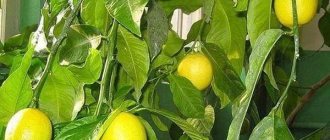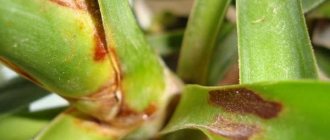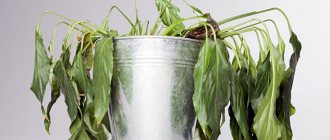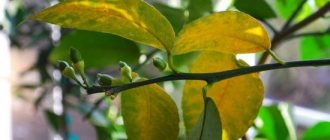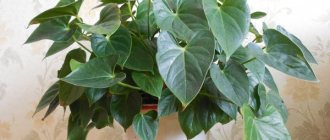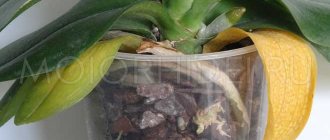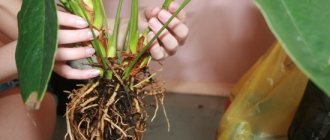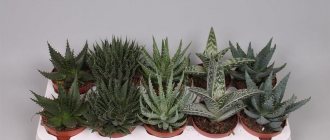The natural place where aloe grows is Africa and the island of Madagascar, where it is warm and dry. By providing the plant with appropriate conditions at home, you can achieve success in cultivation. Otherwise, the tips of the aloe turn yellow and the crop gets sick, even though the plant is practically “indestructible.”
Why do aloe leaves turn yellow and leaf tips dry out?
There are many reasons that cause yellowing and drying of aloe leaves. All of them are associated with violation of growing conditions. As a result, the natural immunity of the plant is reduced.
There are more than 500 types of aloe
Main provoking factors:
- insufficient lighting;
- temperature inconsistency;
- long absence of transplantation;
- pot too big;
- drying out roots;
- pests, diseases;
- using cold water for irrigation;
- lack of nutrients;
- non-compliance with the watering regime.
Problems with leaves can occur in aloe even with a slight violation of the conditions. This is how the plant shows that it needs help. And the sooner the root cause is eliminated, the faster the succulent will recover.
How to save a flower if it dies
Most often, aloe leaves begin to wither due to dysfunction of the root system. This can be caused by a cramped pot, overwatering or drying out. Regardless of the main reason, the plant can only be saved by replanting.
In this case, the damaged roots and leaves are removed and the substrate is completely replaced. The new soil should not only be nutritious, but also contain sand, which will eliminate the possibility of moisture stagnation.
It is important to know! You can water the succulent for the first time after replanting no earlier than a month later.
Temperature
Temperature plays an important role in care. In summer there are usually no problems with this item. But in autumn and winter, the agave lacks sunlight. At this time it is important to prevent it from starting to grow, as the leaves will be pale and limp. To do this, it is necessary to maintain a certain temperature regime - no more than 12 degrees Celsius. To do this, just place the pot near the brightest and coolest window.
We recommend: Aloe vera - description, care, propagation
Improper care of aloe as one of the reasons for drying leaf tips
Why do the tips of leaves on indoor plants dry out?
Often the reason why aloe turns yellow is a violation of the conditions of care and maintenance. It is necessary to consider all possible options, since in each specific case specific signs appear that can help identify the problem.
The lower leaves became stained at the base and fell off
Signs appear as a result of rotting of the stem at the base, which is caused by waterlogging of the soil in combination with low temperature. As a result, metabolic processes in tissues are disrupted. As a result, the root rots and nutrients stop flowing to the upper part of the plant.
Dying of the lower leaves occurs due to problems with the roots
If spots appear on the aloe, namely on the lower leaves, urgent measures should be taken to save the plant. It is necessary to stop the development of rot, which spreads up the stem. To do this, take the aloe out of the pot and remove all the rotten part down to healthy tissue. Dry the cut for 1-2 hours, and then powder the lower part with Kornevin. After this, the plant is planted in a soil mixture of peat and sand, taken in equal quantities.
It is important to know! During rooting, do not cover aloe with a plastic bag, like other plants, as it will rot.
Watering is carried out rarely, in a tray, so that only the bottom layer of soil is moistened. The next moistening is done after the substrate has completely dried. This regime is followed until the plant is completely restored and begins to grow.
The leaves are turning red
If aloe leaves turn red and the tips dry out, this is a sign of sunburn. This is how the plant reacts to bright light. Most often this happens in early spring, when the length of daylight increases noticeably (the plant is placed on the windowsill from partial shade). As a result, the leaves may turn red.
Additional Information! Aloe should be gradually accustomed to bright light after winter and shaded from direct sunlight.
The lower leaves turn yellow
Simultaneous yellowing of several lower leaves can occur for a number of reasons.
If an alarming sign appears in winter, then it indicates the depletion of the flower. This occurs as a result of excessive watering combined with a lack of light. The lower leaves turn yellow, and the top becomes elongated, the plates become thinner and become less fleshy.
Having understood why aloe leaves turn yellow, you need to figure out what to do. In winter, a full 12-hour daylight should be provided using lamps in the evening. If this is not possible, then you need a cool mode of about +12 ℃ and keep the plant in almost dry soil, moderately moistening it once a month.
Yellowing of aloe leaves can be caused by a cramped pot
If the lower leaves turn yellow in summer, there is a lack of nutrients. A common reason is a long absence of replanting or fertilizing. This is how the plant gets rid of old leaves to ensure the growth of new ones. To correct the situation, apply fertilizer for succulents, and if this does not help, then replant it in a new substrate and increase the pot.
Note! Temperature changes can provoke a sharp yellowing of the lower leaves at any time of the year, which will lead to stress. To correct the situation, the conditions of maintenance and watering are adjusted. Moisturize the succulent more often in hot periods, and less often in cool periods.
Aloe leaves are soft
Leaf loss can also be caused by various reasons. During hot periods of the year, when the plant is exposed to direct sunlight, this is observed due to excessive evaporation of moisture. In this case, the plant root is not able to cope with the increased load and make up for the deficiency. To correct the situation, move the plant to a shaded place.
Wilting of aloe leaves can also occur at low temperatures. With a constant regime below +10 ℃ in combination with excessive watering, irreversible processes occur in the plant tissues, which leads to the death of the flower. Aloe can withstand cool microclimates if it is acclimated to the new temperature gradually and watering is limited.
Important! Excessive watering will not solve the situation, as it can lead to rotting of the roots.
Aloe leaves curl
The symptom may appear as a result of drying out roots. This usually happens in winter, when the pot with the plant is located on the windowsill near the heating appliances. In this case, remove the yellowed leaves and then move the flower to another place, providing it with frequent but moderate watering.
Aloe leaves may curl if exposed to direct sunlight. The succulent is trying to protect itself and reduce moisture evaporation. The symptom may appear when dust accumulates on the leaves, which interferes with the process of photosynthesis. It is necessary to regularly wipe the plates, and during hot periods, additionally spray the flower in the evening so that moisture can be absorbed into the leaves before the morning.
Curling aloe leaves are a sign of excessive evaporation of moisture.
Incorrect organization of fertilizing
It’s not enough to just buy the “right” fertilizer for the plant; you also need to know how to apply fertilizer without harming the plant. A few simple rules:
Never feed a plant while it is sick. Do not rush to feed new and recently transplanted plants. In the latter case, it will be much more beneficial for aloe if you treat the roots with a growth stimulator (Kornevin, Heteroauxin) before planting. Make sure that the fertilizer does not get on the trunk or leaf blades of the plant. Fertilize in cloudy weather (to avoid burns if the solution gets on parts of the plant). It is advisable to start in the morning so that by night the top layer of soil has time to dry out at least a little.
If you notice yellow, orange or reddish spots on the leaves of aloe, remember the last time you fed not only the agave, but also other inhabitants of the windowsill. Perhaps, in the process of foliar feeding a neighboring plant, you accidentally got droplets of fertilizer on the aloe, which is why burns appeared on it.
For many people, agave is not only an unpretentious houseplant, but also a valuable raw material for the preparation of growth stimulants or agents for the treatment of various diseases, for example, peeled agave leaf blades can be used to relieve sore throats with sore throat or pharyngitis.
Aloe diseases affecting the condition of leaves
Foliage may also turn yellow due to aloe disease. The most common ones include root and dry rot. In both cases, characteristic signs indicating the disease appear.
Spathiphyllum - home care, why the tips of the leaves dry out
Root rot develops as a result of overwatering, keeping it cool, and planting in an inappropriate substrate that retains moisture. If the plant begins to die, then its leaves turn completely yellow, fall off, the stem at the base becomes dark, and the flower itself bends over. Aloe, like other plants, can be saved by replanting it in new soil.
Procedure:
- Remove the plant from the pot and clean it of soil.
- Examine the roots and remove any parts that cause suspicion.
- Treat the pot with a strong solution of potassium permanganate or boiling water.
- Prepare a soil mixture of sand and peat in equal volumes.
- Place drainage in a layer of 1-1.5 cm at the bottom of the pot.
- Fill the remaining space with the prepared substrate.
- Plant the aloe in the center of the pot and compact the surface.
- Pour sparingly into the tray.
Then move the pot with the plant to a shaded place until it is completely restored. Watering is carried out after the substrate has completely dried and only into the pan.
Note! If the root rot has managed to spread to the stem and leaves, as a result of which they begin to turn black, then it will not be possible to save the aloe.
Dry rot appears as pale, irregular spots on the leaves of the plant. Subsequently they grow. With severe damage, the growth of aloe slows down, and the general appearance becomes depressing. In this case, the leaves do not fall off, and the plant withers. The cause of gray rot is contaminated soil. Treatment in this case is useless.
Excess light
Aloe is very undemanding when it comes to location, but that doesn't mean you don't need to consider its lighting needs. Despite the fact that in nature these plants live in deserts under the scorching rays of the sun, at home in extreme heat they will require shading.
For most of the year, in our area the sun is not as active as in the historical homeland of the agave. And since the plant has managed to adapt to precisely this “gentle” insolation regime, direct sunlight can be destructive for it.
It is especially important to monitor the plant from October to March. At this time, all biological processes that occur in aloe slow down significantly. A hibernating plant will not be able to cope with the active winter sun, so the plant may need additional shading.
Aloe pests as a cause of yellowing and drying of leaves
What to do when the tips of dracaena leaves dry out
Aloe leaves can also dry out and turn yellow as a result of pest damage. This can be determined by careful examination of the aboveground part of the plant.
Damage to aloe by scale insects
Possible problems:
- Spider mite. The small insect is difficult to see with the naked eye. The lesion can be identified by the presence of small light dots along the edge of the leaf blade. Subsequently, a thin cobweb also appears on the leaves and stems.
- Thrips. The pest feeds on the sap of the plant, thereby weakening it. The lesion is identified by the presence of black spots on the leaves. In this case, the plates become yellow and deformed.
- Mealybug. The pest is a white insect. When there is a massive accumulation, a cotton-like coating is noticeable on the leaves. It multiplies in the top layer of soil and then spreads to the leaves and stem of aloe.
- Shield. The pest looks like small, immovable plaques that can be removed with a fingernail. Initially localized along the main stem, and then switches to the leaves. Yellow spots appear in these places.
If there is a small cluster of pests, you can wash the aloe leaves with soap or garlic solution. In case of mass damage, chemical agents are used: Actellik, Fitoverm, Fufanon. The gardener decides which one to choose, depending on the complexity of the situation.
Additional Information! Treatment of the above-ground part should be carried out 2-3 times at intervals of 5-7 days, alternating preparations. In the case of scale insects, the plant is additionally watered with Aktara’s working solution.
Pests
Pests that constantly attack flowers become a real disaster for lovers of indoor plants. Because they can not only damage, but also destroy green areas.
Spider mite
Yellowing leaves and a thin web of light webs are a symptom that the plants have been attacked by the most common pest - spider mites. With such a tiny size - about 1 mm, the insect does a lot of harm. Having settled in a colony on the underside of young leaves, the mite sucks out the tender juice, depleting the plant.
If the yellow turns to red and then the leaf dies, you should act immediately:
- move the plant away from others, isolating and preventing infection;
- treat the flower with acaricides - preparations intended to control pests;
- Repeat treatment of all leaves twice with an interval of 5 days.
Important! It is advisable to do this on the balcony, on the street or, in extreme cases, in the bathroom late in the evening, then tightly closing the door. Because the products are not only harmful to humans, but also have a strong, unpleasant odor.
In addition to long-used effective drugs, folk recipes are also used. For example, shavings of laundry soap are diluted in a decoction of onion peels and the plant is treated, carefully wiping each leaf with a sponge.
The influence of scale insects and false scale insects
Scale looks like a small plaque on the trunk or leaf of a plant. It also settles in a colony and sucks out the juice, depriving the flower of the forces so necessary for growth and development. Leaves in damaged areas dry out. With severe lesions they turn yellow, and then dark reddish, later brown spots appear on them. After which the leaf dies.
The false scale insect is very similar in appearance to the scale insect. It inhibits photosynthesis by feeding on juice and pulp, and also deprives the plant of its ability to grow. The pest injects a toxic substance into the spaces formed in the places of its “activity”. Which quickly leads to the death of the flower.
The plant should be immediately isolated from the rest. Carefully treat the place where it stood and the plant itself with special preparations or garlic tincture. Some use alcohol solutions to save aloe and other flowers from this pest, also wiping all the leaves and trunk.
Mealybug
Noticing that the tips of the aloe leaves began to turn yellow, and the trunk suddenly seemed to be covered with pieces of wax, flower growers understand that the reason is a mealybug. The places covered by this pest begin to rot, deprived of oxygen.
Attention! The scale insect does not like moisture. Therefore, to combat it, sometimes it is enough to treat the plant with special compounds containing alcohol or a small amount of apple cider vinegar. They must be used carefully so as not to burn the aloe.
After carefully wiping every centimeter of the succulent, you need to move it to semi-darkness for several days. This will increase your chances of getting rid of the mealybug. Within 10 days, repeat the treatment 3 more times, using regular wet wipes.
What to do if you have problems with roots
The most dangerous reason that aloe begins to die is a dysfunction of the root system. As a result, not only the leaves may disappear, but the plant itself may rot or dry out.
The main signs of problems with roots:
- unpleasant odor in the soil;
- excessive exposure of the succulent at the base;
- stop in development;
- the trunk below begins to turn black and the leaves disappear;
- the plates become sluggish.
If at least some alarming symptoms appear, measures are taken to save the flower. To do this, take it out of the pot and remove all damaged areas to healthy ones. Then they are washed from the remnants of the contaminated soil and transplanted into another pot and new soil.
Transplantation is the only way to save dying aloe
What to do to prevent pests?
Preventing diseases and pests is much easier than fighting them and their consequences. To protect plants, you just need to carefully observe them, noting all changes. And also take precautions when replanting or the appearance of new “neighbors” on the windowsill. Replant, fertilize and process in a timely manner. Water on time and do not disturb the temperature regime.
It is worth adhering to these requirements when caring for the plant:
- When using old pots when replanting, gardeners should not forget to treat them with disinfectant compounds.
- When rooting new cuttings, be sure to choose a larger container. So that the roots have enough room to grow.
- The soil taken from the garden plot should be heated in the oven or poured with boiling water to destroy pests.
- Wipe the aloe leaves and inspect the trunk weekly. Thanks to this, you can not only notice warning signs in time, but also prevent the appearance of diseases and pests.
A strong, healthy plant can easily withstand both stress factors and various diseases. And flower growers can keep their pets healthy only by carefully caring for the greenery in their home. With proper care, monitoring the condition of the soil, and timely elimination of violations in technology, both aloe and other flowers will delight you all year round.
How to revive a completely dried out plant
Flower growers often ask: if aloe dries out, how to replant and restore the plant? This issue needs to be looked into.
If there is no watering for a long time, the root system stops functioning, and therefore stops feeding the leaves. Abundant watering in this case will only speed up the death of the succulent.
You can save the flower by rooting the top. To do this, cut it with a clean knife and dry the cut for 1-2 hours. After this, sprinkle with any root-forming agent and plant in a mixture of peat and sand in a 1:1 ratio.
Important! During the rooting period, aloe is watered once every 3 weeks and through a tray so that only the bottom layer of soil is moistened.
Lack of space
Once the aloe has settled down well after being transplanted into a new pot, it immediately begins to produce numerous side shoots. At some point, the plant’s stems no longer have enough space outside the pot, and its roots become cramped inside. The aloe root system fills all the free space, which is why the agave begins to experience a shortage of water and nutrients and gradually dries out. However, some shoots may look quite healthy.
Cut out “extra” side shoots in a timely manner, regularly divide and replant the agave into larger containers.
How to care for a plant so that there are no problems
Aloe is an unpretentious plant, but if the requirements are ignored, it begins to wither. Many problems can be avoided if you follow simple care rules:
- Aloe needs good lighting, so it is recommended to keep it on a southern or eastern windowsill with shade from direct sunlight.
- The pot for the plant can be used either clay or plastic, but its diameter should be 2 times smaller than the crown.
- Watering should be carried out as the soil dries into the pan or along the edge of the pot. To do this, use settled water at room temperature.
- Soil for planting should be purchased with a special mark “For succulents”.
- A flower under 5 years old is replanted annually in the spring, and older - once every 3-4 years.
- Fertilizing is carried out regularly in the warm season, using fertilizers for succulents. In the autumn-winter period, they are reduced to 1 time per month and the concentration is halved.
- The leaves of the plant are periodically cleaned of dust so that the process of photosynthesis proceeds normally.
- During particularly hot periods of the year, the leaves are sprayed in the evening.
Aloe is a medicinal succulent that can forgive the grower minor mistakes in care. With constant violation of the rules of agricultural technology, the plant’s immunity decreases, which leads to problems with leaves and roots.
When to transplant?
It is recommended to replant young plants every year, old ones - once every couple of years. It is best to do this in March, when the agave is ready for active growth after the winter period.
For replanting, use a pot that is slightly larger in size than the old one. Drainage is poured at its bottom. Then - a small layer of soil, place the plant on it and continue to fill the pot. You can sprinkle a layer of small pebbles on top to avoid erosion of the soil and rotting of the roots.
Methods to combat them
To prevent problems in growing aloe, it is first of all important to provide the plant with proper and timely care, as well as create favorable conditions. First of all, you need to find out what is the cause of the problem with agave
At the initial stages of disease development, aloe can be cured without the use of drugs. Solving the problem depending on the symptoms:
- if the bush begins to wither and stops growing, it is urgent to replant and apply fertilizer;
- leaf blades locally begin to darken and lose their natural rich green color, which means it is necessary to reduce the frequency and abundance of watering and move the flower to a warm place;
- leaf blades that are curled and dried at the edges can be saved by increasing the humidity level in the room by spraying;
- Fading, yellowing and beginning to dry agave plants must be removed from lighted areas and watering increased.
After each watering, be sure to loosen the soil in the pot. It is the stagnation of moisture in the soil that is one of the most important reasons for the appearance of fungi and mold, which are very difficult to fight. It is imperative to monitor the quality of irrigation.
Important! Do not water indoor flowers with tap and cold water. Water should be at room temperature and settled
To do this, running water is left in a wide container for a day to remove the chlorine. It is necessary to constantly stir the liquid so that excess elements do not stagnate at the bottom of the container.
Transplanting into a larger pot solves many problems.
Folk remedies
Showering under warm water and washing the leaves with a soapy solution helps in the early stages of powdery mildew and spider mites. In general, washing aloe leaf blades should be carried out constantly as a preventive measure against diseases. Dust not only accumulates harmful microorganisms on the leaf blades, but also spoils the appearance of the agave.
Aloe leaves have turned yellow, what to do in this situation? It is necessary to spray and treat the soil with a solution of iron sulfate twice in the first 2-3 weeks. Then repeat the procedure every week until the bush regains its natural color.
To remove mold and fungi, treat the soil with a solution of potassium permanganate. This method is a disinfectant and kills pathogens in the soil. If the problem is advanced and the bush cannot be saved with potassium permanganate alone, you need to transplant the bush into new soil and pot. Before planting, it is necessary to treat the root system with a weak solution of potassium permanganate and remove areas that have begun to rot.
Important! After work with the soil, it is necessary to disinfect used garden tools
Chemical substances
It is recommended to treat agave with special chemicals. Fungicides help against infections, mold and fungi. It is necessary to choose a medicine specifically for deciduous plants. Bordeaux mixture is effective against yellowing of leaves.
The insecticides tekta, vedat, fufanon, and intavir save from pests. Acaricides are used against spider mites that can destroy the pest and promote healing of the affected areas of the plant.
Note! Insecticides do not help in treating spider mites, since the insect is an arachnid
Aloe is an indispensable houseplant in every household.
Aloe is an indispensable assistant for every housewife. It is valued not only for its decorative effect, but also for its beneficial medicinal properties. Therefore, it is doubly unpleasant when aloe turns yellow and gets sick. Achieving healthy and active growth of agave is not at all difficult, the main thing is to carry out the necessary procedures regularly and correctly.
The plant has died or rotted: reasons and what to do
Why might the flower die? This could happen as a result of a serious illness that was neglected or improper care. It is very important to notice and diagnose the disease in time, so that you can then know how to deal with it. Timely detection of the disease is the key to successfully saving the plant .
Important : If the aloe root system has completely rotted, and along with it the stems, then such a plant cannot be saved; all that remains is to throw it away.
The only option to revive it is to try to transplant the cut stem into a clean container with new soil. You will need soil for cacti, mixed with river sand and rotted soil. The succulent also needs good drainage .
What do the spots mean?
You can identify plant problems by looking at the color of the leaves. These may be the cases:
Brown spots on the leaves indicate that the bushes lack moisture. In this case, you need to reconsider the watering scheme and periods. If the spots are dark and soft, then the plants are dying from the fungus. In such a situation, you need to treat the bush with an antifungal drug. If the flower has acquired a black leaf, this indicates severe contamination. In this case, the salvation lies in maintaining cleanliness and wiping the plants from dust. But if the leaves in the agave turn red, then this is not dangerous. Thus, the flower reacts to the sun's rays. If you put it in a darker place, the leaves will soon return their color. Other problems: Sometimes the plant withers and dies right before your eyes. If the leaves begin to curl and fall off, the water for irrigation is too cold. The flower may die if the leaves turn pale and wither. This happens when you water too much.
If the tips of the leaves of any aloe dry out and the edges turn yellow, then water with chlorine was used for irrigation, and the plant also lacks potassium.
Yellowness at the base
There is only one explanation for such a negative process - the soil is too waterlogged. Very often, due to constant waterlogging of the soil, rhizomes begin to rot. This leads to the appearance of root rot. This disease gradually rises from the roots to the base of the plant and, if the aloe disease is not overcome in time, it may die completely.
How to fix the situation?
You need to remove the flower from the flowerpot, clean the roots from the soil and remove all rotten areas.- It is also necessary to cut off all damaged parts on the stem before a healthy layer appears.
- Afterwards, all cut parts need to be washed, dried and sprinkled with crushed coal.
- Let the flower brew for several hours and only after that the aloe is planted in the pot.
The container for the flower should be small. At first, you need to water rarely and only through a tray until the perennial adapts.
You will find more information on what to do if medicinal aloe in a pot rots, withers and disappears here.
Aloe
In the aloe plant, the most valuable is acemanan, a carbohydrate from the mucopolysaccharide group.
For metabolic processes, the main essential nutrients are carbohydrates. An adult gets acemanan only through food, since it is produced independently before puberty. Ginseng also contains acemanan. Treatment with aloe juice must be carried out with caution. In advanced stages of oral diseases, this remedy provokes complications
Treatment using traditional recipes can reduce pain and alleviate the patient’s condition, but cannot eliminate the inflammatory process.
If patients are taking medication, it is prohibited to eliminate the inflammatory process in the oral cavity with aloe juice. It has been proven that the effectiveness of the effects of drugs is reduced due to the beneficial composition of the plant.
The use of medicinal decoctions, tinctures and aloe juice is prohibited for people susceptible to allergic reactions to the plant and for patients who suffer from inflammatory processes. If discomfort occurs, or itching or various allergic reactions occur, the use of aloe should be stopped immediately.

